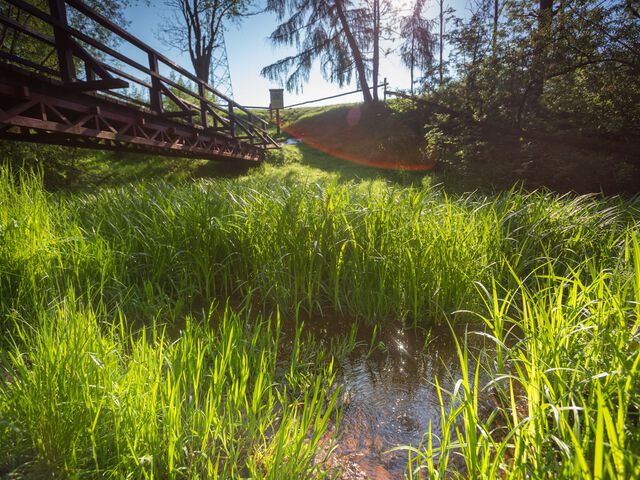



Inanimate nature monument Prof. Henryk Świdziński
The mofeta is situated at the bottom of the boggy bed of the Złocki stream, thanks to which the CO 2 outflow takes place partially under the water cover and is therefore perfectly visible. At several points, an area of approximately 25 square meters, getting out continuously day and night different sizes and with variable frequency CO 2 bubbles. There are several springs of mineral waters in this area. The largest is called the Bulgotka, the other, the Sunken one, is covered with the water of the stream; there is also a lonely dry exhalation of carbon dioxide - Dychawka. These names perfectly illustrate their characteristic features, because bursting bubbles make hissing and gurgling sounds, and from the waterless Dychawka you can hear the "breath" of the earth.
The escaping gas has a very high CO 2 content, amounting to 94.3%, and its composition also includes N 2 - 4.17% and O 2 - 0.44%. This gas comes from a deep subducted in the Miocene under the Carpathian orogen and genetically it is associated with juvenile tertiary volcanism and / or low-temperature metamorphism of carbonate rocks.
The exceptionally attractive setting of the mofettes is influenced by the bubbling rusty-yellow mud, contrasting in color with the intensely green, low-growing vegetation overgrowing them. It precipitates from the waters of sorrel flowing here, containing a large amount of iron compounds, and is a colloidal, red-brown gelatinous suspension, thin coating or foamy gel. This sediment also contains many minerals washed from the rocks of the substrate, such as: quartz, kaolinite, illite, montmorillonite, calcite, feldspar and chlorite. This rusty sediment is colloquially called "ore" and its accumulation can lead to the formation of ocher, a mineral that has been valued since the Palaeolithic times.
The vegetation growing in the area of mofeta occurrence belongs to the group of wet and muddy habitats. It grows in dense clumps here: forest bulrushes, creeping moss, marsh mud, bitter watercress, marsh hugger, common carupus, common wheatgrass, long-leaved mint, forget-me-not, runner buttercup and manna.
The mofette has been made available to visitors according to the design of AGH UST employees: Lucyna Rajchel, Jacek Rajchel and Tomasz Wieja in cooperation with the Poprad Landscape Park.
Free
5,3 km
Używamy plików cookies aby zwiększyć funkcjonalnośc strony oraz zbierać statystyki odwiedzin witryny.
Zaakceptuj i kontynuuj.